These expert tips will help you fuel properly so you can outsmart constant “runger.”
You should never be running to justify eating—we don’t “earn” our food; we eat to fuel our love of running—but there’s hardly a runner out there who doesn’t appreciate ending a run and going HAM on the first thing they find in their kitchen to refuel. “Runger” is real, but running isn’t the only thing to blame for your insatiable appetite.
Running burns a lot of calories—13.2 calories per minute for a 140-pound person, according to the American Council of Exercise—and calories are your body’s fuel. Replacing those calories is just as important a part of your training strategy as logging miles. The 2015 to 2020 edition of the Dietary Guidelines for Americans says active men should consume up to 3,000 calories a day, while active women should consume up to 2,400 calories a day. If you’re not consuming enough, you may be well-acquainted with post-workout “runger.”
With a full work schedule, family obligations, and the desire to, you know, have a social life, making sure you’re getting enough fuel can be challenging. But managing hunger pangs isn’t just about hitting a certain calorie quota. And if you’re constantly ravenous, you might need to check your eating (and exercise) habits.
Is it normal to feel hungry all the time?
Exercise isn’t the only way you burn calories, although that can be a major source of energy expenditure. “Many people aren’t aware that our basal metabolic rate (BMR), essentially the amount of energy you expend just to stay alive, makes up the majority of energy expended each day, even for the active population,” says Kelly Jones, R.D., a Philadelphia-based sports dietitian. “Your BMR must support breathing, heart beat and blood circulation, brain activity, body temperature regulation, central nervous system function, and more.”
Your BMR, a.k.a. your metabolism, is influenced by gender, age, height, and weight, but it also increases with a higher ratio of lean tissue to fat tissue (the kind of body composition that benefits runners) and is higher when you’re recovering from strenuous exercise, she explains. If you’re consciously or unconsciously limiting calories, that number could be drastically lower than what you need, which leads to feeling hungry frequently.
Obviously, though, exercise does deplete your normal calorie stores, and you do need extra calories to rebuild your muscles, keep your bones strong, and prevent fatigue. Unfortunately, determining what you need isn’t as simple as adding 300 calories on to your 2,400- or 3,000-calorie-per-day quota to make up for that three-mile run. Generally speaking, people—especially athletes—should eat to meet their needs, says Jenna Braddock, R.D.N., a specialist in sports dietetics and a certified personal trainer. “If your stomach is growling, then you need food. If you feel your energy, focus, or connectedness declining, you also probably need food,” she adds.
Hunger is normal, but a hunger pang doesn’t always mean you need food. If you’ve eaten in the past hour or so, before eating again, it’s a good idea to drink some water first, says Braddock. Thirst and hunger are regulated in the same part of your brain, and it’s easy to mistake dehydration for an empty stomach. And when you’re stressed, your body releases the same hormones as it does when your blood sugar is too low, says Jones. Those hormones tell your body you need more energy, which many people interpret as needing food, but you may just need a nap or quick walk over another cookie from the break room.
Still not sure if your hunger cravings are normal? “Generally, every two to four hours is a common rhythm of hunger,” says Braddock. Gauge your appetite by that time frame. Most importantly, tune in closely to your body to learn your own personal patterns.
[Build a killer midsection in the kitchen for effortless miles on the road with Eat for Abs.]
Why do I always feel hungry after eating?
What’s more nutritionally disappointing than finishing a meal that checks off all your “healthy eating” boxes than feeling starved for more an hour later? You may have simply not eaten enough calories, and your body is craving more nutrients.
“The biggest signs that you’re not eating enough are: consistent fatigue, reoccurring ‘annoying’ injuries such as shin splints, high frequency of upper respiratory infections, difficulty sleeping despite being tired, and irritability,” says Braddock. “These all signify that you’re not getting enough energy to support your body’s needs.”
If you know you have consumed enough calories, you may not be eating the right ones. A good, satiating meal should be filled with quality protein (such as chicken breast, grass-fed beef, and bison), quality carbohydrates (such as quinoa, whole grain bread, oats, sweet potatoes, and bananas), healthy fats (such as avocados, nuts and seeds, olive oil, and salmon), and plenty of fruits and vegetables that provide vitamins and minerals, too.
It’s trendy to cut carbs right now (hello, keto diet), “but if your intake of carbohydrate is low, the body may still crave food,” says Jones. Ah, carbs—they’re so important because they’re the most easily accessible energy source during exercise (especially high-intensity exercise), and your body needs this nutrient in adequate amounts so it can be stored in the muscles for the next time they need to be active, she explains. If you’re already all about the carbs, though, you might be eating carbs that are low in fiber and not as filling as you need for high mileage.
On the flip side, if you’re logging lower mileage, you might be easily satisfied by meals or snacks that lack the filling fiber, fat, and protein you actually need. “I recommend all meals and snacks include a balance of these nutrients,” says Jones. “Rather than just grabbing a banana as a snack, add some peanut butter. Or, rather than just nuts, add some crackers and hummus.” Hitting multiple macros (carbohydrates, protein, and fat) at once is a solid way to feel sated.
Why am I eating a lot more than usual?
This is kind of a no-brainer: If you’re burning a ton of calories all the time, you’re going to feel hungry. And if you’re feeling hungry all the time, it makes sense that you’d end up eating a lot more.
But there are a couple other reasons you could be craving seconds or even thirds post-workout. Running is, by nature, a high-intensity sport. “If you’re doing high intensity exercise a lot, you’re sending your body the signal that you are now a high-intensity athlete,” says Braddock. In response, your body is going to work harder—and use more energy—to keep everything in homeostasis.”
And then there’s the afterburn effect. “High-intensity exercise burns more calories both during and afterwards,” says Braddock. Because your metabolism is still revving post-workout, it’s immediately using the calories you eat after a run to replenish your depleted energy stores. That could leave you feeling hungry again soon afterwards.
Did you start incorporating speed intervals or cross-training? “Exercising in any way that’s less normal for you can increase your hunger and appetite further,” says Jones. “You may have a high level of fitness due to running often, but if you’re less efficient swimming or weight-lifting, your body will have plenty of extra recovery to engage in, which requires more energy.”
How can I stop feeling hungry all the time?
Alleviating hunger is not about eating more, but rather eating smarter. Obviously, you want to make sure you’re getting enough carbs. “Making sure you include protein and fat at meals can help satiate you at the meal and keep you feel satisfied longer,” says Braddock. “Both these macronutrients digest more slowly, staying in your stomach longer, and providing more of a trickle of energy into your bloodstream. Since you have a steady stream of energy and volume in your stomach, the appetite mechanisms of your body will not be initiated as frequently.”
Don’t just grab snacks mindlessly, either. Assess what you’re craving, then ask yourself what you can add, says Jones. Do you tend to get protein and fat but no carbs? Vice versa? Is there enough fiber? Fill in the gaps from there. Strategic snacking—or making sure you’re consuming at least two macronutrients—can help prevent an empty-feeling stomach. “Eating these right before you typically get hungry or before your energy crashes can help you stay more even keeled throughout the day, in both energy and appetite,” says Braddock.
If your constant hunger coincides with higher mileage, make sure you’re fueling duringexercise. “As a general rule of thumb, I encourage fueling during runs that last longer than an hour, and ingesting 60 grams of carbohydrate per hour (and up to 90 grams for those running marathon distances or longer),” says Jones. “This helps provide energy when your body needs it so it isn’t trying to play catch up quite as much afterwards.”
And remember that hunger is not just about what you put in your stomach. A healthy diet goes hand-in-hand with proper hydration, good sleep, and stress management. If one domino falls, the rest are more likely to—and there’s no chance that isn’t going to affect your performance.






Recent Comments